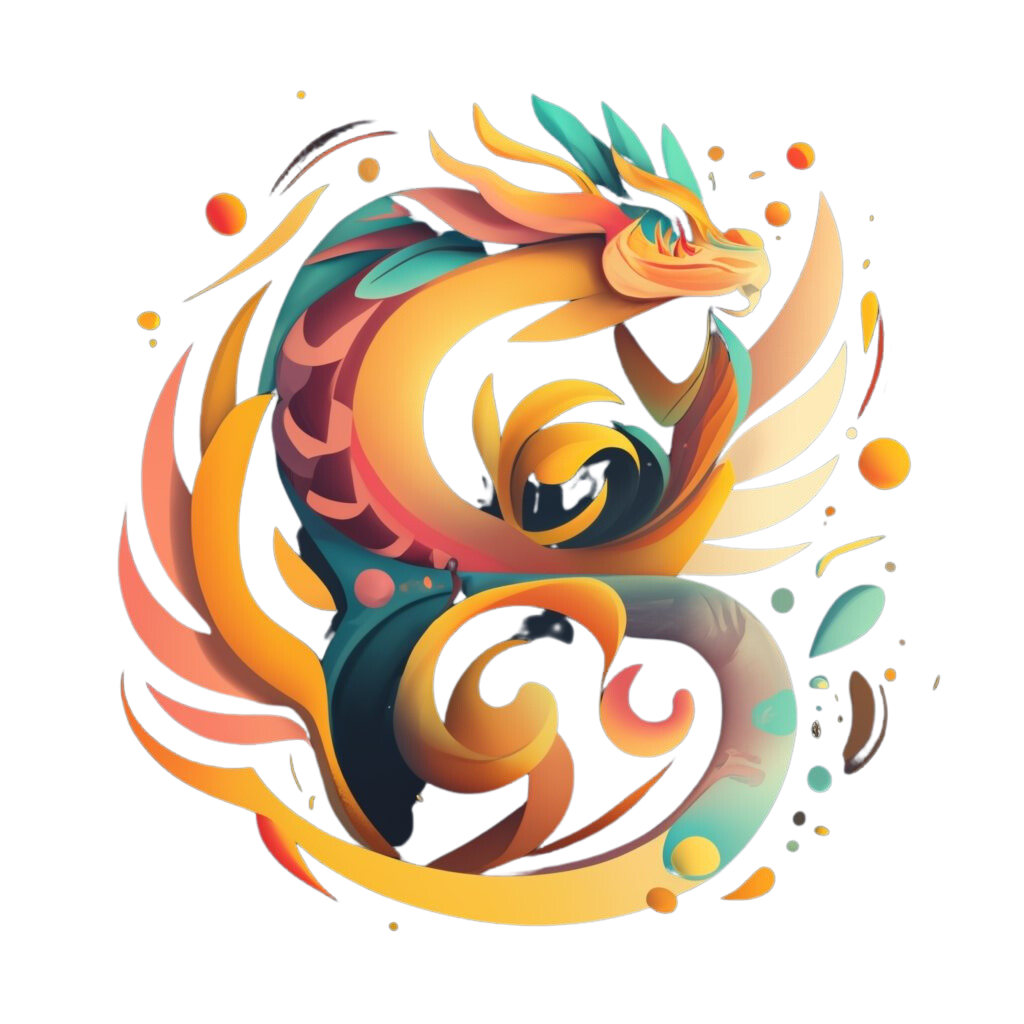Brazilian folklore is full of mythical creatures that amaze people everywhere. These legendary beings are a big part of Brazilian culture. They have stories and traits that are special to Brazil.
Brazil has many mythical creatures, each with its own tale. These stories show the creativity of Brazilians. They inspire and amaze people today. Whether you're curious about Amazon creatures or city legends, Brazilian folklore is captivating.
Key Takeaways
- Brazilian folklore is home to a diverse array of mythical creatures and legendary beings.
- These creatures are an integral part of Brazilian culture and identity.
- Brazilian mythical creatures can be found in the Amazonian rainforest and the country's vibrant cities.
- The country's mythical creatures are a testament to the creativity and imagination of its people.
- Brazilian folklore and mythology continue to inspire and fascinate audiences today.
- Brazilian mythical creatures are a unique and fascinating part of the country's cultural heritage.
The Rich Tapestry of Brazilian Folklore and Mythology
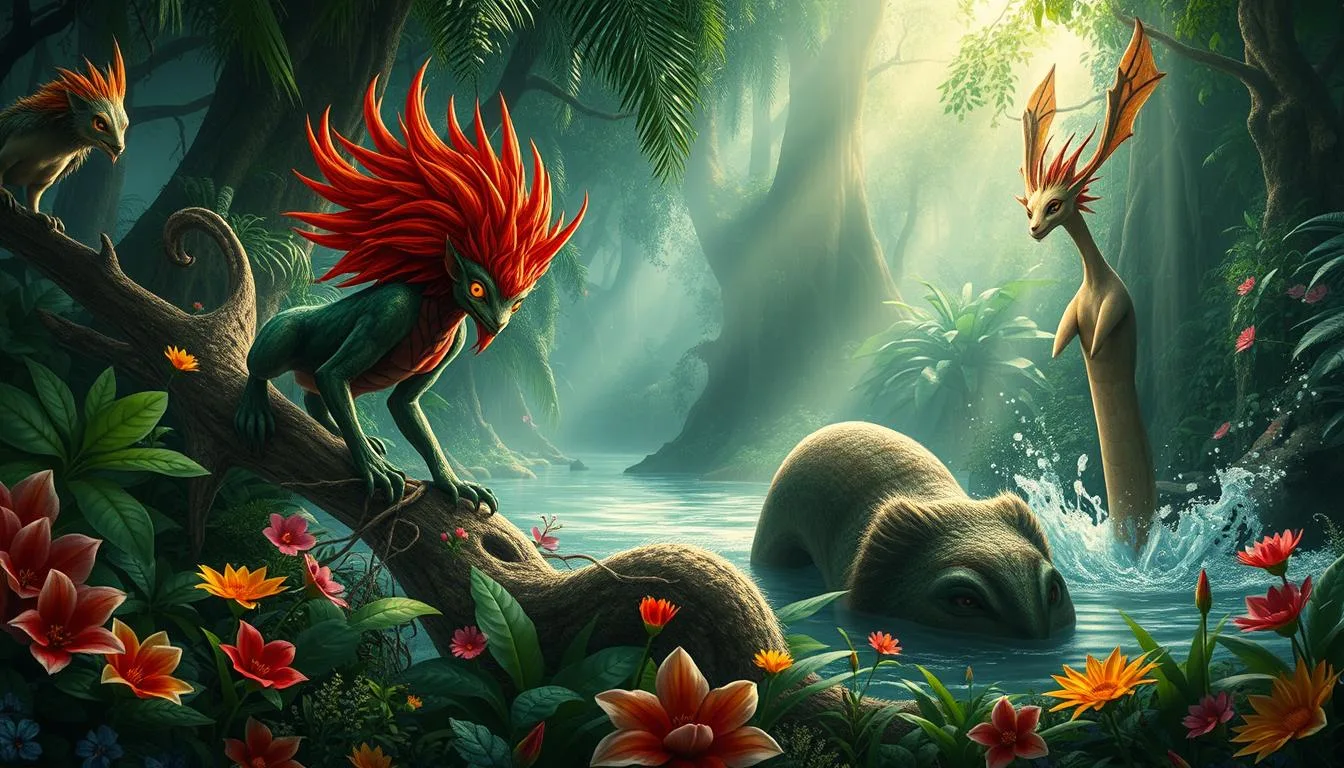
Brazilian folklore is full of life and stories. It shows the country's rich history and myths. These myths have amazed people for a long time.
At the heart of Brazilian folklore are many mythical creatures. Each one has its own story and traits. The Curupira and the Boto are famous examples. They show Brazil's deep connection to nature and its culture.
Indigenous and African cultures have shaped Brazilian folklore. The Tupã spirit from indigenous people and the Orishas from Africa are examples. These stories have been passed down for generations.
Some key aspects of Brazilian folklore and mythology include:
- Mythical creatures, such as the Curupira and the Boto
- Indigenous influences, such as the Tupã spirit
- African cultural contributions, such as the Orishas
- Cultural significance, reflecting the country's connection to its natural environment and cultural heritage
Brazilian folklore and mythology are unique and fascinating. They show the country's rich cultural heritage. By learning about these stories, we can understand why they are important.
| Mythical Creature | Description | Cultural Significance |
|---|---|---|
| Curupira | Mischievous forest spirit | Symbolizes the country's connection to its natural environment |
| Boto | Shape-shifting pink river dolphin | Represents the power of transformation and adaptation |
| Tupã | Indigenous spirit with control over nature | Embodies the indigenous people's respect for the natural world |
Origins and Evolution of Brazilian Mythical Creatures
Brazilian mythology is full of stories and legends. It comes from the mix of different cultures. This mix includes indigenous, African, and Portuguese influences.
Indigenous Influences on Brazilian Mythology
The indigenous people of Brazil have shaped the country's myths. Their stories have been passed down for many years. These stories are seen in the mythical creatures we celebrate today.
African Cultural Contributions
African cultures have also shaped Brazilian myths. Many African stories have been added to the folklore. This mix makes Brazilian myths unique and interesting.
Portuguese Colonial Impact
The Portuguese colonial period also influenced Brazilian myths. European folklore and myths were introduced. This has made Brazilian mythology diverse and complex.
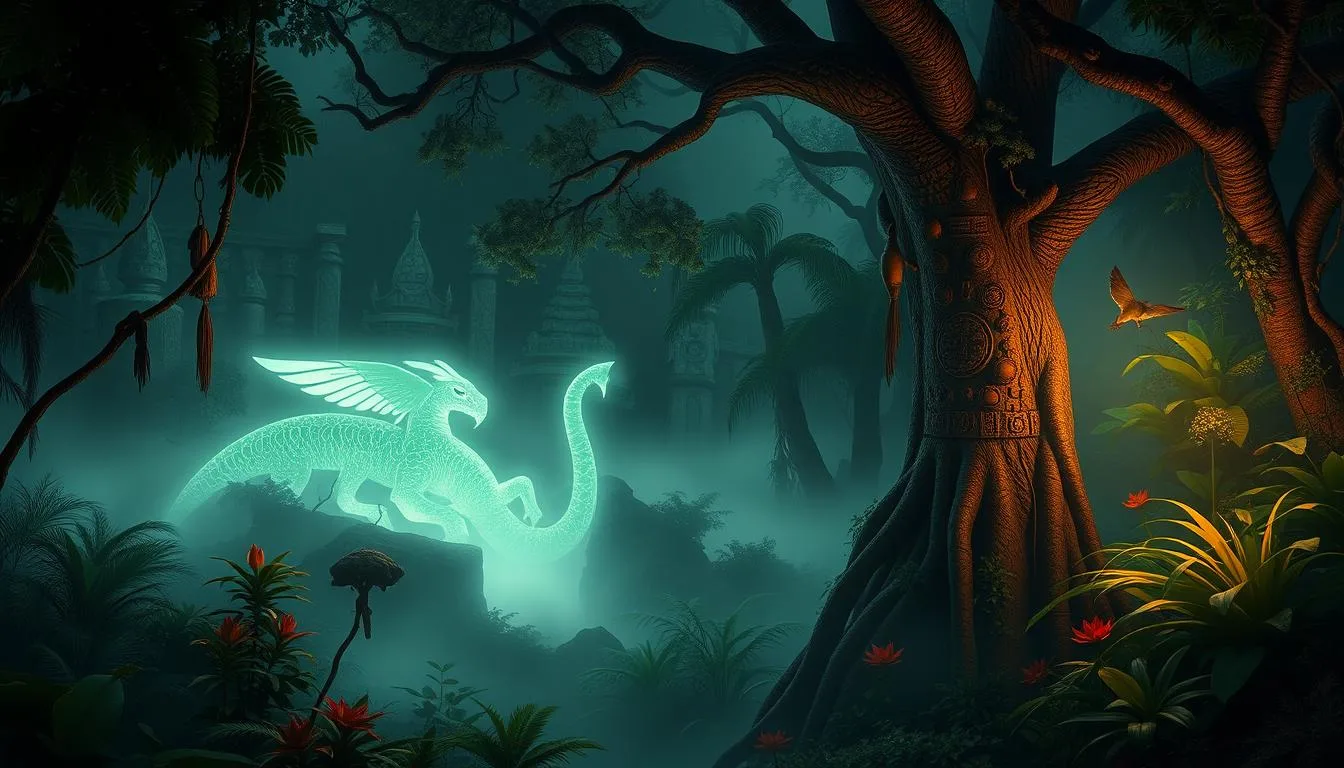
Studying Brazilian mythical creatures is very interesting. It shows us a lot about Brazil's history and culture. By looking at how folklore has changed, we learn more about these creatures' importance in Brazilian society.
Famous Brazilian Mythical Creatures in Modern Culture
Brazilian folklore is big in today's culture. Famous mythical creatures like the Curupira and the Boto show up in movies, books, and art. They bring Brazil's rich culture to life for people everywhere.
These creatures are shown in cool ways in modern media. The Curupira is a small, playful being with bright red hair. The Boto is a dolphin that can change shape. These images show off Brazilian folklore's creativity and importance today.
Some famous examples include:
- The Curupira, a small, mischievous creature with bright red hair, which has been featured in various films and literature.
- The Boto, a shape-shifting dolphin, which has been depicted in art and literature as a symbol of transformation and adaptability.
- The Mapinguari, a giant sloth monster, which has been featured in various forms of media, including film and video games.
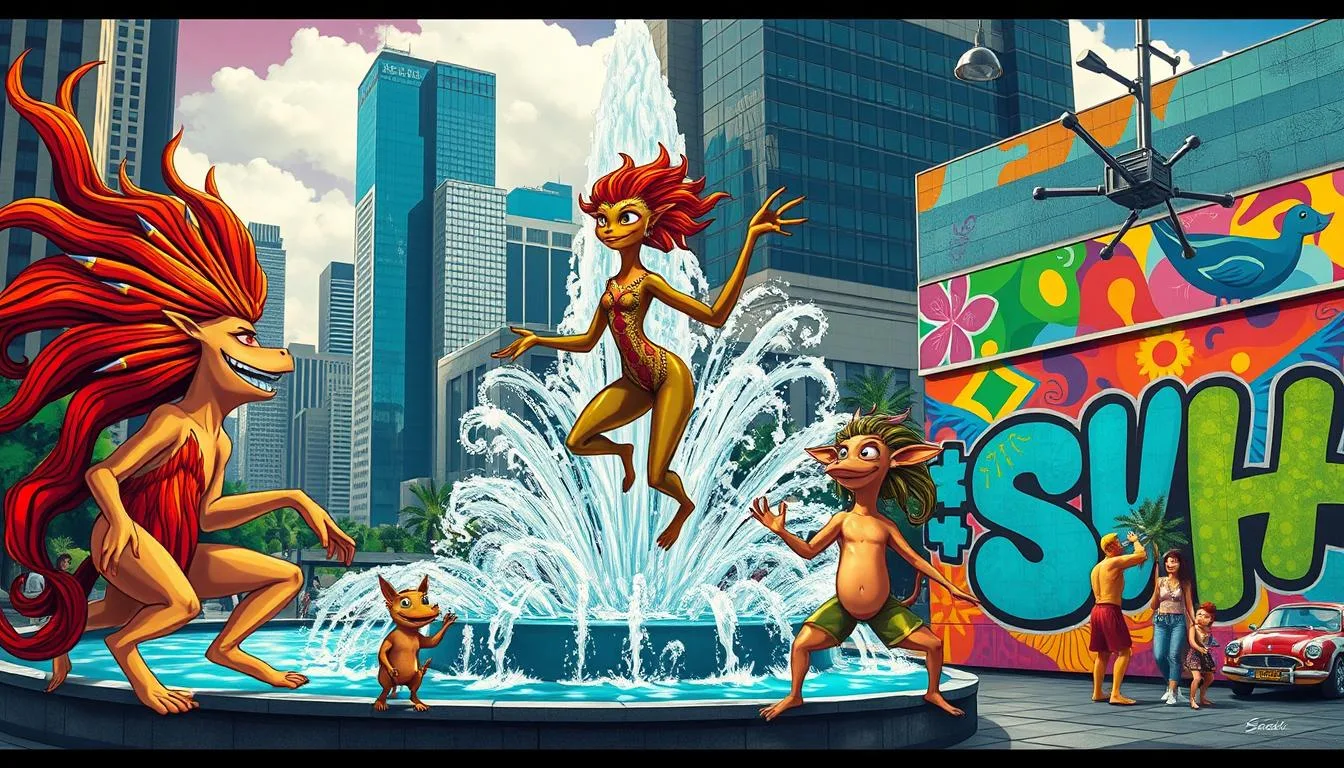
The presence of Brazilian mythical creatures in today's culture shows their lasting charm. They keep drawing in fans worldwide, inspiring new creators. By looking at these creatures in modern culture, we learn more about Brazilian folklore's value to our shared cultural heritage.
| Mythical Creature | Representation in Modern Culture |
|---|---|
| Curupira | Featured in films and literature as a small, mischievous creature with bright red hair. |
| Boto | Depicted in art and literature as a shape-shifting dolphin, symbolizing transformation and adaptability. |
| Mapinguari | Featured in various forms of media, including film and video games, as a giant sloth monster. |
The Amazon's Most Fearsome Legendary Beings
Deep in the Amazon, there are scary creatures that have amazed people for ages. These legendary beings are key to the region's stories. They show the special traits and tales of the Amazon.
The Amazon is full of legendary beings, each with its own look and powers. The Boto, Curupira, and Mapinguari are some of the most famous. They are a big part of Amazonian myths, inspiring many stories.
Boto: The Pink River Dolphin Shapeshifter
The Boto is a legendary being from Amazonian myths. It can change into a human. This creature lives in the Amazon's rivers and streams, drawing humans in with its beautiful voice.
Curupira: Guardian of the Forest
The Curupira is a legendary being from Amazonian myths. It guards the forest. This creature can control nature, keeping the forest and its people safe.
Mapinguari: The Giant Sloth Monster
The Mapinguari is a legendary being from Amazonian myths. It is huge and strong. This creature roams the Amazon's forests, making everyone who hears of it feel fear and respect.
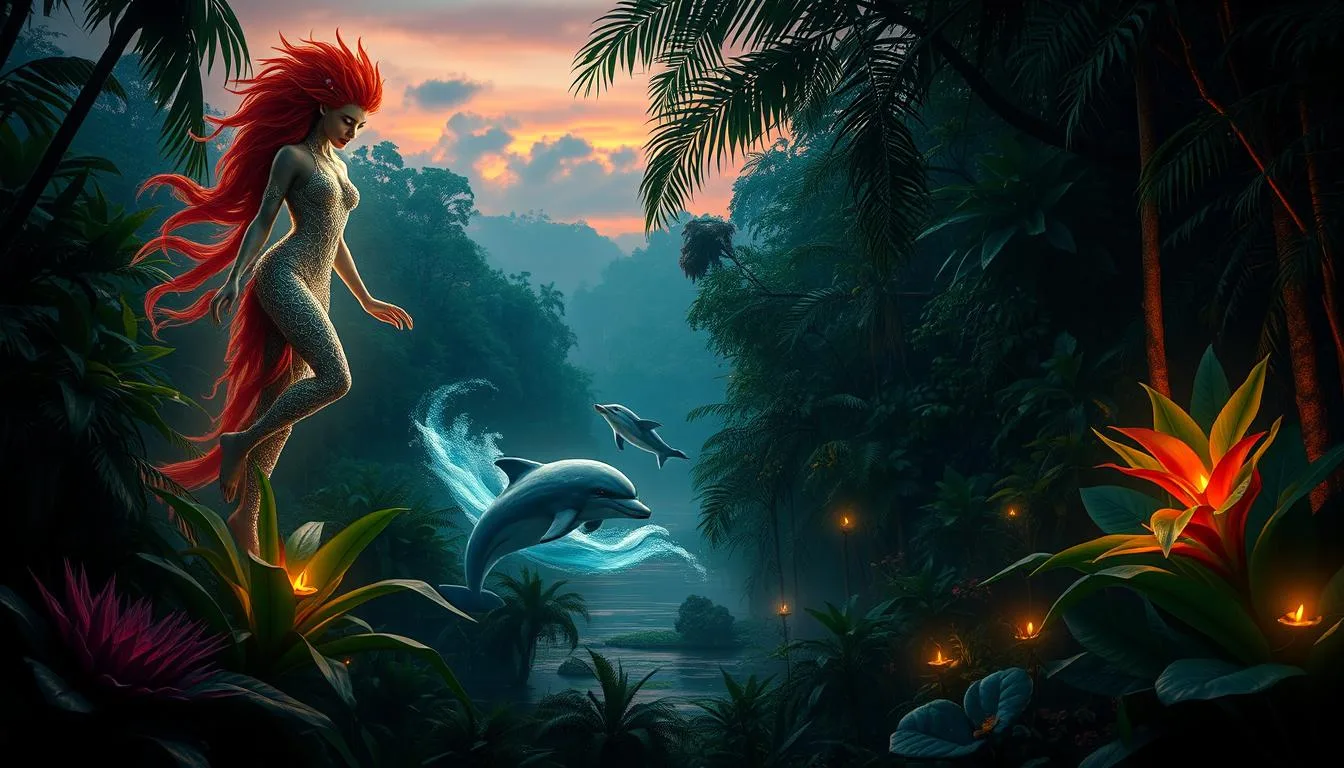
These legendary beings are a big part of Amazonian myths. They show the unique traits and stories of the Amazon. The myths of these creatures have been shared for generations, inspiring many stories and legends.
Supernatural Guardians of Brazilian Waters
Brazilian waters have many mythical creatures. Each one is special and important. They protect the rivers, lakes, and oceans in Brazil.
The Yacumama is a serpent in the Amazon River. The Boto is a pink dolphin that can change into a human. These creatures are fascinating and very important to Brazilian culture.
Here are some key facts about the supernatural guardians of Brazilian waters:
- They are often associated with the country's indigenous and African cultures.
- They are believed to possess supernatural powers, such as shape-shifting and healing.
- They are revered and respected in Brazilian culture, with many stories and legends surrounding their existence.
The supernatural guardians of Brazilian waters are a big part of the country's myths. They show the deep bond between nature and the spiritual world. Learning about these creatures helps us understand Brazilian culture better.
| Mythical Creature | Description | Cultural Significance |
|---|---|---|
| Yacumama | Serpent-like creature inhabiting the Amazon River | Protector of the river and its inhabitants |
| Boto | Pink river dolphin with shape-shifting powers | Symbol of good luck and prosperity |
Urban Legends and Brazilian Mythical Creatures
Brazilian mythical creatures are a big part of the country's stories. These tales have been shared for many years. Now, people are talking more about seeing these creatures in real life.
Stories about the curupira and the boi-bumbá are very common. The curupira is a small, playful creature from the forests. The boi-bumbá is a legendary bull that roams the countryside. These tales are a big part of Brazilian folklore.
Modern Sightings and Stories
Today, people are sharing stories of seeing these creatures. The media is full of reports about the mapinguari and the boto. The mapinguari lives in the Amazon rainforest. The boto is a dolphin that can change into a human.
Regional Variations
Every region in Brazil has its own mythical creatures. In the northeast, there's the caboclo, a forest spirit. In the south, there's the gauchinho, a spirit of the countryside.
These stories and sightings are very interesting. They show how much people love these tales. Even if you don't believe in them, they are a big part of Brazilian culture.
The Role of Mythical Creatures in Brazilian Society
Mythical creatures have been a big part of Brazilian society for a long time. They help shape the country's culture. These creatures teach us important lessons and morals.
In Brazil, mythical creatures teach kids about values like respect and kindness. For example, the Curupira teaches kids to love nature. These creatures also help control society.
Environmental Protection Messages
Many mythical creatures in Brazil teach us to protect the environment. They show us why we need to save the Amazon rainforest. They also teach us to live sustainably and reduce waste.
- Teaching children about the importance of preserving the Amazon rainforest
- Promoting sustainable practices and reducing waste
- Highlighting the impact of human actions on the environment
Social Control Functions
Mythical creatures in Brazil also teach kids about social values. They help us understand the country's rich culture. These creatures are very important in Brazilian society.
Artistic Representations Through History
Art in Brazil has always shown mythical creatures. This art lets us see the culture and history of these legends. Over time, these creatures have been shown in books, paintings, and movies.
Some famous examples are:
- Literary works, such as novels and poems, that feature Brazilian mythical creatures as main characters or symbols
- Visual arts, such as paintings and sculptures, that depict these creatures in a realistic or stylized manner
- Films and documentaries that showcase the mythology and cultural significance of Brazilian mythical creatures
This art shows Brazil's rich culture and history. It helps us understand the values of the past.
In short, the art of Brazilian mythical creatures is key to understanding Brazil's culture. It gives us a special look at these legends' history and importance.
How Brazilian Folklore Shapes Cultural Identity
Brazilian folklore is key in shaping the country's culture. It shows the values and traditions of Brazilians. Stories passed down through generations are a big part of this.
Festivals and Celebrations
Festivals in Brazil celebrate its rich culture. They bring people together, showing unity. For instance, the Festa do Divino Espírito Santo honors Catholic traditions with music, dance, and food.
Literature and Media
Brazilian folklore inspires many writers and artists. It's kept alive through stories told and written. This helps share Brazilian culture with the world.
Traditional Storytelling
Storytelling is a big part of Brazilian folklore. Stories are shared by word of mouth. This keeps the culture alive, blending indigenous and African influences.
Key aspects of Brazilian folklore include:
- Promoting cultural heritage and traditions
- Preserving oral traditions and storytelling
- Influencing literature and media
- Shaping cultural identity and values
Preserving the Magic: Why These Legends Matter Today
As we wrap up our look at Brazilian mythical creatures, it's clear they're loved worldwide. These legends are more than just stories. They connect the past to today and shape Brazil's identity.
The tales of the Boto shapeshifter, Curupira, and Mapinguari are full of wonder. They teach, entertain, and help protect the environment. By keeping these stories alive, we celebrate Brazil's heritage and inspire others to cherish these tales.
To explore how South American legends compare, don't miss our deep dive into the eerie Argentine mythical creatures that still haunt folklore—a chilling collection of mythical creatures rooted in Argentine tradition and supernatural lore.
FAQ
What are the most famous Brazilian mythical creatures?
Famous creatures in Brazil include the Boto, a shape-shifting dolphin. There's also the Curupira, a forest guardian. And the Mapinguari, a giant sloth-like monster.
How do Brazilian mythical creatures reflect the country's cultural diversity?
These creatures show Brazil's mix of cultures. They come from indigenous, African, and Portuguese roots. This mix is seen in their unique stories and traits.
What role do mythical creatures play in Brazilian society?
They teach about protecting the environment. They also help keep social norms strong. And they keep cultural identity alive through stories and celebrations.
Are there any modern sightings or urban legends surrounding Brazilian mythical creatures?
Yes, there are stories today. Like the Boto seen in cities and the Mapinguari in the Amazon.
How are Brazilian mythical creatures represented in art and literature?
They appear in many art forms. From books and movies to crafts and paintings. These show their cultural importance and lasting charm.
Why is it important to preserve the magic of Brazilian mythical creatures?
Saving their magic is key. They represent Brazil's heritage, values, and traditions. They enchant people worldwide and shape Brazilian identity.
While Brazilian legends brim with forest spirits and shapeshifters, exploring the Colombian mythical creatures from ancient folklore reveals a distinct blend of jungle protectors, ghostly figures, and cultural fusion from Indigenous, African, and Spanish roots.
Learn more about mythical creatures from other parts of the world:
